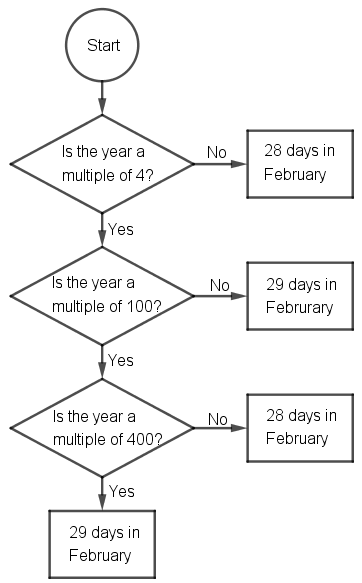Month
Pronunciation: /mʌnθ/ ExplainA month is measurement of time based on days and years. Each year is divided into twelve months. Each month has between 28 and 31 days. Table 1 shows the months in order and how many days are in each month.
| Number | Name | Number of days |
|---|---|---|
| 1 | January | 31 |
| 2 | February | 28 or 29 |
| 3 | March | 31 |
| 4 | April | 30 |
| 5 | May | 31 |
| 6 | June | 30 |
| 7 | July | 31 |
| 8 | August | 31 |
| 9 | September | 30 |
| 10 | October | 31 |
| 11 | November | 30 |
| 12 | December | 31 |
| Table 1 - months | ||
The number of days in February is 28 days for three years, then 29 days on leap year, except every 100 years when there is no leap year, except every 400 years when there is a leap year after all. The flow chart in illustration 2 shows how this works.

|
| Illustration 2 - Leap year flow chart. |
Mnenmonic
The following poem is a mnemonic for remembering the number of days in each month:
Thirty days has September, April, June and November.
All the rest have thirty-one
Except February which has twenty-eight or twenty-nine.
A Brief History of Months
People have been working on systems to measure the passage of days for many thousands of years. The solar year (the time it takes for the earth to rotate about the sun) and the calendar year usually were different. The calendar year was often several days shorter than the solar year. Because of this, in one year winter might start in November, but ten year later it could start in January, and ten years after than in March.
After many variations on calendars, the Gregorian calendar set the official length of a year at 365.245 days (365 days + 1/4 days - 1/100 days + 1/400 days). The system of leap years was used to keep the calendar year closely synchronized with the solar year. Today, scientist also use 'leap seconds' to keep the calendar year even more closely aligned with the solar year.
References
- McAdams, David E.. All Math Words Dictionary, month. 2nd Classroom edition 20150108-4799968. pg 120. Life is a Story Problem LLC. January 8, 2015. Buy the book
Cite this article as:
McAdams, David E. Month. 12/21/2018. All Math Words Encyclopedia. Life is a Story Problem LLC. https://www.allmathwords.org/en/m/month-2.html.Image Credits
- All images and manipulatives are by David McAdams unless otherwise stated. All images by David McAdams are Copyright © Life is a Story Problem LLC and are licensed under a Creative Commons Attribution-ShareAlike 4.0 International License.
Revision History
12/21/2018: Reviewed and corrected IPA pronunication. (McAdams, David E.)9/4/2018: Removed broken links, updated license, implemented new markup. (McAdams, David E.)
8/7/2018: Changed vocabulary links to WORDLINK format. (McAdams, David E.)
5/26/2011: Initial version. (McAdams, David E.)
- Navigation
- Home
- Contents
-
# A B C D E F G H I J K L M N O P Q R S T U V W X Y Z - Teacher Aids
- Classroom Demos
- How To
- LIASP
- LIASP Home
- Conditions of Use
- Privacy Policy
- Donate to LIASP
- Help build this site
- About LIASP
- Contact LIASP
All Math Words Encyclopedia is a service of
Life is a Story Problem LLC.
Copyright © 2018 Life is a Story Problem LLC. All rights reserved.
This work is licensed under a Creative Commons Attribution-ShareAlike 4.0 International License